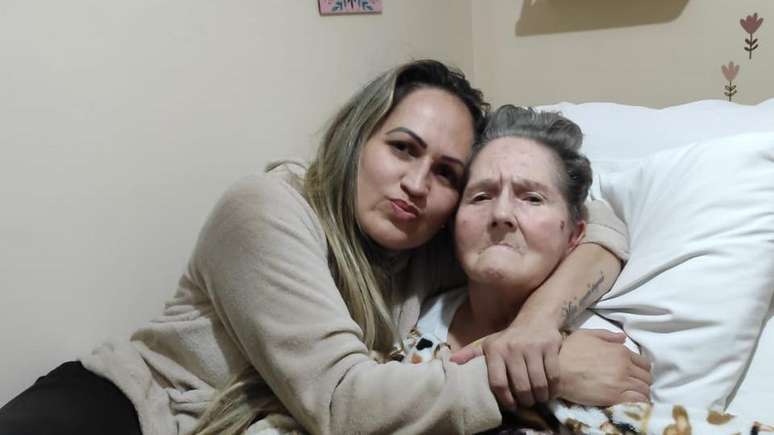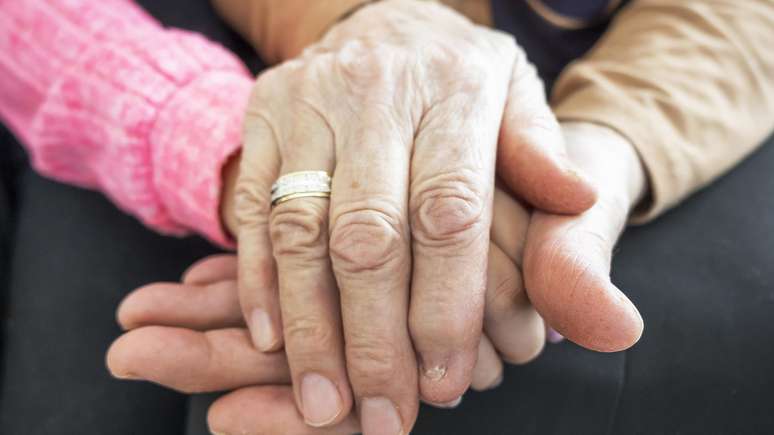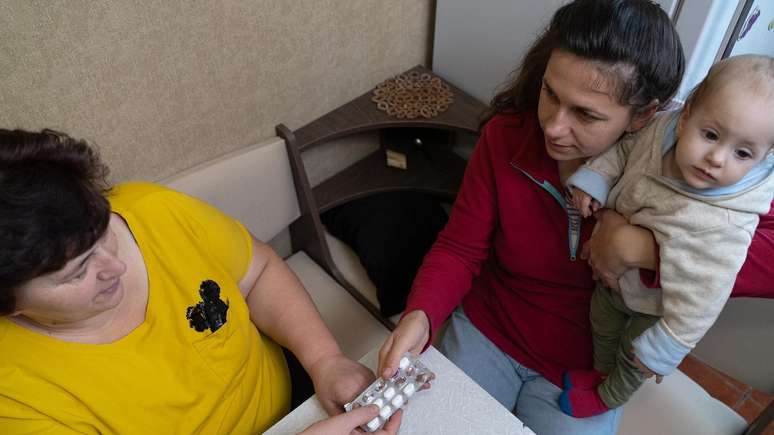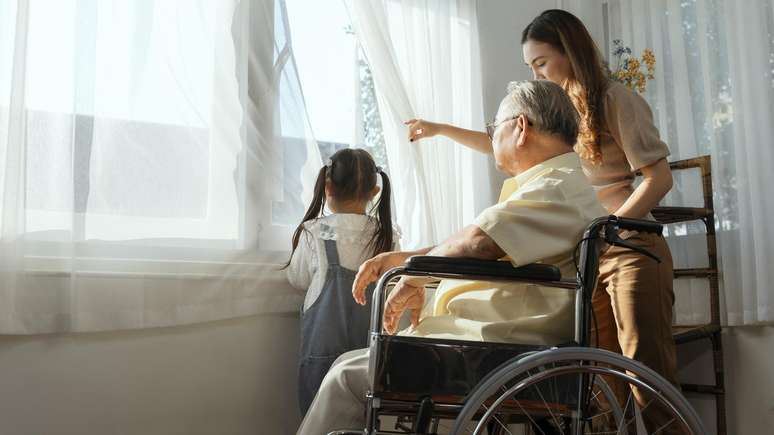‘I lost my mother and gained another daughter to take care of besides my own’, a Brazilian story ‘compressed’ between the needs of two generations; phenomenon is growing in Brazil and in the world due to social and demographic changes.
html[data-range=”xlarge”] figure image img.img-696d19869df5be7f0b17c76a3b1b585bi38ufno2 { width: 774px; height: 435px; }HTML[data-range=”large”] figure image img.img-696d19869df5be7f0b17c76a3b1b585bi38ufno2 { width: 548px; height: 308px; }HTML[data-range=”small”] figure image img.img-696d19869df5be7f0b17c76a3b1b585bi38ufno2, html[data-range=”medium”] figure image img.img-696d19869df5be7f0b17c76a3b1b585bi38ufno2 { width: 564px; height: 317px; }
For ten years, Lady Daiane de Vargas Flores has been taking care of her mother, who suffers from dementia. Dona Maria Joana is 68 years old and no longer speaks, walks or feeds.
“She’s become a total child,” Daiane, 39, explains to BBC News Brasil.
The worst phase of Dona Maria Joana’s illness occurred just when Daiane was about to become a mother, pregnant with a child who is now 7 years old.
“When you’re having a baby, you want your mother to be by your side. But what happened to me is that I became motherless and had an extra daughter.”
Daiane is not alone in the challenge of taking care of two generations at the same time: the demographic and social changes taking place all over the world mean that it is increasingly frequent for families, especially women, to be simultaneously “pressed” by the needs of both elderly parents and both need care and children – or even grandchildren – who also require constant attention and financial support.
The name given to this, internationally, is the “sandwich generation” — which in Brazil takes on even more complex contours (see more details below in the report).
In the United States, for example, a Pew Center survey estimated that nearly one in four American adults potentially fit this definition, meaning they have responsibilities to both elderly parents over the age of 65 and their minor children ( or older).18 years old but still financially dependent).

The age group most likely to be “sandwiched” is the 1940s: More than half (54%) of Americans in this age group have parents and children who may need care or financial assistance.
There are no accurate statistics on the phenomenon in Brazil, according to the specialists consulted by the report. Data from the IBGE’s Continuous National Household Sample Survey (Continuous PNAD) in 2019 show that 54.1 million Brazilians aged 14 and older cared for other residents of their home or other relatives, but did not it is known for certain how many take care of two generations at the same time.
Despite this, the expectation is that the “sandwich generation” phenomenon will become more common in the near future, as Brazilian researchers Simone Wajnman and Jordana Cristina Jesus explain in a study on the subject in Brazil.
There is a combination of reasons behind this global phenomenon: as people have children later and their parents live longer, many find themselves dealing with two generations of care.
At the same time, families have become smaller and there are fewer people to share these chores with.
Another important factor, according to the Brazilian researchers, is that a significant number of young people have taken longer to achieve financial independence, postponing leaving the parental home.
“They are thought to have spent more and more time dependent, especially compared to their parents’ generation,” Wajnman and Jesus point out.
‘The scenario generated by these changes is that of an ever-increasing number of adults simultaneously depressed by the needs of their children and their parents, (…) with women more likely to fill this role.’
Statistics confirm this propensity: according to the IBGE, women spend, on average, 10.4 hours a week more than men on household chores and unpaid care for people.
This is the case of Daiane, who has taken care of Dona Maria Joana alone since her father’s death. Neither her husband nor her siblings participate in routine care, she says.
“I learned to wash her and I do everything in my power. When she was still talking, she even called me mom. (…) I think God gave me this so I could learn what true love is for someone. – because it is an experience of love».
But the accumulation of duties with her son, with her mother and with household chores has taken a toll on Daiane’s mental health. She says she has gone through periods of deep depression.
“I dedicate my whole life to my mother: I don’t travel, I don’t go out. (…) And people ask that I be more present for my son. I don’t have time for myself, but I have to have time for the house, for the clothes, for them”.
“sandwich” grandparents.

But if stories like Daiane’s are classic examples of the sandwich generation around the world, they probably aren’t yet a quintessentially Brazilian example, says Simone Wajnman, a professor at UFMG.
In the country, as in the rest of Latin America, the phenomenon has a further layer of complexity: according to the data collected by the researcher, most of the women “sandwiched” currently in Brazil are not only mothers, but also grandmothers.
The main reason behind this is that, although more and more Brazilian women are waiting longer to have children, the average age of becoming mothers – 27.8 years – is still one of the lowest in the world.
Analyzing data from the 2010 census, Wajnman identified that by the time this woman reaches age 55, she will have, on average, two grandchildren, born to children between the ages of 20 and 30.
“And he also has a very high probability of having a living mother and an adult father,” Wajnman explains to BBC News Brasil.
In practice, therefore, many of these grandmothers end up squeezed by the needs of three different generations of employees and often participate intensely in the lives and care of all of them.
“It’s definitely something that affects women a lot more,” Wajnman continues. “I’m talking about grandparents who have a lot of work with their grandchildren and at the same time have a demanding mum or dad”.
And they also reconcile it with family support.
Raquel Soares Alexandre, from São Paulo, 58, says she hasn’t had “a life of her own” for three years, since her father suffered a stroke (stroke) and lost movement on the right side of her body.
“He doesn’t walk or talk, so it’s up to me to take the meds, go to the doctor’s appointments, everything,” he says on the report.
Raquel also raises her two teenage nieces (13 and 17 years old) and works full-time as a support agent at Fundação Casa, in the city of São Paulo.
“My father stays with one of my granddaughters in the morning and with the other in the afternoon. When I get home from work I still have to take care of the food. I go to sleep at 11pm. And on my days off, I have to take care of the house, wash the clothes,” she says.
“So ‘tight’ is not enough. I cry a lot, I despair, but then you look to the side and see people in an even worse situation and you move on. (…) Before my father got sick, I managed to go on vacation to the sea. Today if I go away for a few days it’s already a nuisance, because I have to pay someone to take care of him and I can’t get away from it”.
The weight of care

Importantly, multigenerational coexistence can also bring gains, from bringing families closer together and even allowing mothers to be able to remain in the market while grandmothers help with the children.
But the emotional and economic pressure on this demographic is great and is likely to continue to grow.
A recent survey by the University of Michigan, in the USA, published in the Journal of the American Geriatrics Society points out that, among more than a thousand respondents of the “sandwich generation” in the USA, 36% of them were in financial difficulty – double the reported rate among people who cared only for an elderly father, for example.
Also noteworthy was the high rate (44%) of emotional distress among those entered.
“Policymakers and employers will need to pay particular attention to people in this ‘trilemma’ of caring for two generations while remaining part of the workforce,” wrote Donovan Maust, one of the study’s authors.
The American Psychological Association (APA) states that “being a multigenerational caregiver has been shown to negatively impact health and behavior by reducing (caregivers’) levels of exercise, increasing smoking frequency, and increasing the risk of depression.”
“Taking care of grandchildren is an extra job for grandparents who are often also carers for their husbands. We are talking about women who often did not know how to choose,” says social worker Marilia Berzins, of the Observatório da Longevidade Humana e Envelhecimento (Watch ) in Brazil.
Berzins says she’s even given classes and lectures to help multigenerational caregivers, but they just didn’t have the spare time to attend. Without support, they end up learning to care for the elderly basically, on their own.
“It’s precarious and heavy work. Today, the main provider of care is the family itself,” Berzins continues.
He argues that public policies, such as day or night care centers for the elderly and formalizing the profession of caregiving, could help ease the emotional, social and financial burdens of these groups.
“The question is: who takes care of who takes care of them? This is why care needs to become a state policy, and not just a family policy”.
Source: Terra
Ben Stock is a lifestyle journalist and author at Gossipify. He writes about topics such as health, wellness, travel, food and home decor. He provides practical advice and inspiration to improve well-being, keeps readers up to date with latest lifestyle news and trends, known for his engaging writing style, in-depth analysis and unique perspectives.





![We belong to us in advance tomorrow [SPOILERS] We belong to us in advance tomorrow [SPOILERS]](https://fr.web.img5.acsta.net/img/bf/ea/bfea87fabe1a11eec60d7d44053b2793.jpg)



